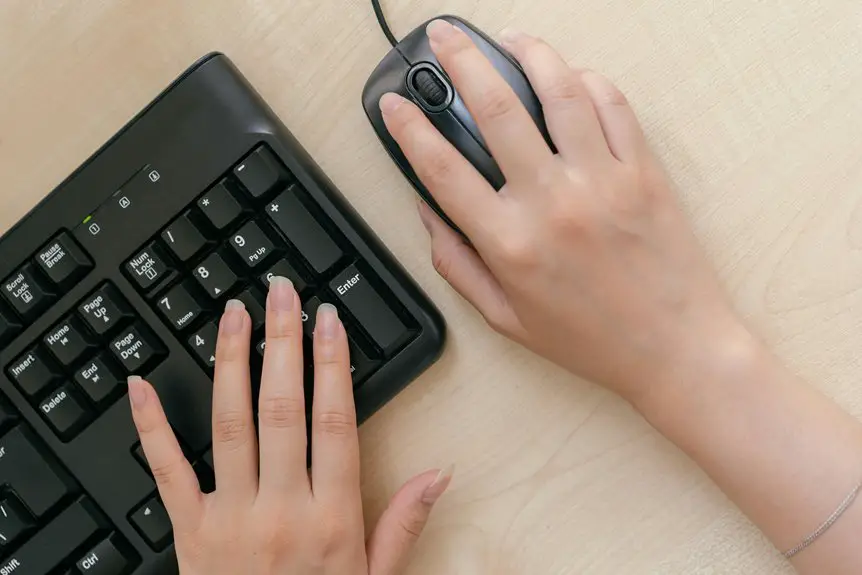When it comes to keyboard ergonomics, the position of your wrists can significantly impact your typing experience. You might find that a slight wrist extension allows for faster typing, while a neutral position is often recommended for comfort. But how do you strike the right balance? Understanding the nuances between these positions is crucial for optimizing your performance and avoiding discomfort. Let's explore the implications of each approach and what you can do to protect your wrists.
Table of Contents
Key Takeaways
- A neutral wrist position aligns the wrist with forearms, reducing the risk of repetitive strain injuries and promoting comfort during typing.
- Wrist extension can enhance typing speed and fluidity, allowing for a more natural motion that reduces muscle tension.
- Maintaining a neutral wrist position improves overall posture, reducing tension in the shoulders and neck during prolonged typing sessions.
- Poor wrist positioning can lead to chronic issues like carpal tunnel syndrome, numbness, and muscle strain in the forearms and shoulders.
- Regular breaks and proper adjustments, such as chair height and monitor level, are essential for minimizing strain and enhancing typing comfort.
Understanding Wrist Positioning
When you're typing, the position of your wrists plays a crucial role in preventing strain and discomfort. Ideally, your wrists should be in a neutral position, aligned straight with your forearms. This alignment minimizes the risk of repetitive strain injuries and promotes better blood circulation.
Avoid bending your wrists upwards or downwards; those positions create undue pressure on your muscles and tendons. Instead, keep your hands slightly hovering above the keys, allowing your fingers to reach comfortably without forcing your wrists into awkward angles.
Using a keyboard with a slight incline can also help maintain this neutral position. Regularly check your wrist alignment while typing to ensure you're not developing bad habits that could lead to long-term issues.
The Case for Wrist Extension
When you extend your wrists while typing, you might notice an increase in your typing speed.
This position can also help reduce muscle tension, making your sessions more comfortable.
Let's explore how wrist extension can enhance your overall typing experience.
Increased Typing Speed
Although many people underestimate the impact of wrist position on typing speed, proper wrist extension can significantly enhance your performance. When you allow your wrists to extend slightly while typing, you create a more fluid motion, which can result in faster keystrokes. This position helps maintain a natural alignment that promotes efficiency.
| Position | Speed Increase | Comfort Level |
|---|---|---|
| Neutral Position | Moderate | Moderate |
| Slight Wrist Extension | High | High |
| Severe Wrist Extension | Low | Low |
Reduced Muscle Tension
Maintaining the right wrist position not only boosts your typing speed but also plays a significant role in reducing muscle tension.
When you keep your wrists in a slightly extended position, you allow your muscles to relax, minimizing the strain that often leads to discomfort. This position encourages a more natural alignment of your forearm, wrist, and hand, preventing excessive bending that can cause tightness.
By adopting wrist extension, you can distribute workload more evenly across your muscles, reducing the chance of fatigue during long typing sessions.
Plus, less tension means fewer interruptions from discomfort, allowing you to maintain focus and productivity.
Prioritizing wrist extension can lead to a more comfortable and efficient typing experience overall.
The Benefits of a Neutral Wrist Position
Achieving a neutral wrist position not only enhances comfort but also plays a crucial role in preventing repetitive strain injuries.
When you maintain this position, you can experience several benefits:
- Reduced Discomfort: Your wrists won't feel strained, allowing for longer, more productive work sessions.
- Improved Posture: A neutral position promotes better alignment, reducing tension in your shoulders and neck.
- Enhanced Typing Efficiency: You'll find it easier to type, as your fingers can move freely without unnecessary resistance.
- Lower Risk of Injury: By avoiding awkward angles, you significantly decrease the likelihood of developing chronic issues.
Common Risks Associated With Poor Wrist Positioning
When you type with poor wrist positioning, you risk a host of discomforts and injuries that can hinder your productivity.
You might experience wrist pain, which can escalate to conditions like carpal tunnel syndrome or tendonitis. Your fingers may also feel numb or tingly, making it difficult to maintain focus on your work.
Additionally, you could develop muscle strain in your forearms and shoulders due to unnatural posture. Prolonged poor positioning can lead to chronic problems that require medical intervention.
It's not just about discomfort—these issues can affect your overall efficiency and well-being.
How to Achieve a Neutral Wrist Position
To achieve a neutral wrist position, you need to start with the right keyboard height that allows your wrists to remain straight and relaxed.
Consider incorporating wrist support options, which can help maintain that optimal alignment during long typing sessions.
Making these adjustments can significantly reduce strain and improve your overall comfort.
Proper Keyboard Height
Finding the right keyboard height is essential for maintaining a neutral wrist position, which can reduce strain and enhance comfort during long typing sessions.
To achieve this, follow these simple steps:
- Adjust your chair so your feet are flat on the floor, with knees at a 90-degree angle.
- Position your keyboard so it's at or just below elbow height, allowing your arms to rest comfortably at your sides.
- Keep your wrists straight and your hands floating above the keys, avoiding any bending or extension.
- Test your setup by typing for a few minutes to ensure comfort and adjust as necessary.
Wrist Support Options
Several effective wrist support options can help you achieve a neutral wrist position while typing. Consider using a wrist rest, which provides cushioning and prevents your wrists from bending too much. An adjustable keyboard tray can also be beneficial, allowing you to set your keyboard at the ideal height.
Here's a quick comparison of wrist support options:
| Type of Support | Benefits |
|---|---|
| Wrist Rest | Cushions wrists, promotes neutral position |
| Adjustable Tray | Customizable height, reduces strain |
| Ergonomic Keyboard | Built-in support, encourages proper alignment |
Tips for Reducing Strain During Typing
While you mightn't realize it, simple adjustments to your typing habits can significantly reduce strain on your hands and wrists. Here are some tips to help you type more comfortably:
- Keep your wrists straight: Align them with your forearms to minimize pressure.
- Take regular breaks: Every 30-60 minutes, step away from your keyboard to stretch and relax your hands.
- Use proper posture: Sit up straight with your feet flat on the floor and your monitor at eye level.
- Adjust your chair height: Ensure your elbows are at a 90-degree angle and your hands float above the keyboard.
Implementing these tips can make a noticeable difference in your typing comfort and overall wrist health.
Choosing the Right Keyboard for Your Needs
How can you choose the right keyboard to enhance your typing experience?
First, consider your typing style. If you type for long hours, a mechanical keyboard with tactile feedback might reduce fatigue. Look for ergonomic designs that promote a neutral wrist position, like split or angled keyboards.
Next, think about key travel and noise. Do you prefer soft, quiet keys or clicky ones? This choice can affect your comfort and focus.
Additionally, explore wireless options for a cleaner workspace and portability.
Lastly, test out different models in-store if possible. Your ideal keyboard should feel comfortable and suit your specific needs, helping you maintain productivity without strain.
Frequently Asked Questions
How Often Should I Take Breaks While Typing?
You should take breaks every 30 to 60 minutes while typing. Stand up, stretch, and rest your hands. Regular breaks help reduce strain, improve focus, and maintain productivity throughout your typing sessions.
What Are Signs of Wrist Strain or Injury?
If you're experiencing pain, swelling, or stiffness in your wrists, it might be a sign of strain or injury. Numbness or tingling sensations can also indicate that you need to take a break and reassess your posture.
Can a Wrist Rest Help With Ergonomics?
A wrist rest can definitely help with ergonomics. It supports your wrists, reducing strain during typing. However, ensure it's the right height so your wrists stay in a neutral position while you work.
Are There Specific Exercises for Wrist Health?
Yes, there are specific exercises for wrist health. You can try wrist stretches, flexor and extensor strengthening, and rotating your wrists regularly. These activities can enhance flexibility, reduce tension, and improve overall wrist function.
How Does Keyboard Height Affect Wrist Position?
Keyboard height significantly affects your wrist position. If it's too high or low, you'll strain your wrists. Adjusting it to elbow level helps maintain a neutral position, reducing discomfort and promoting better typing posture.




